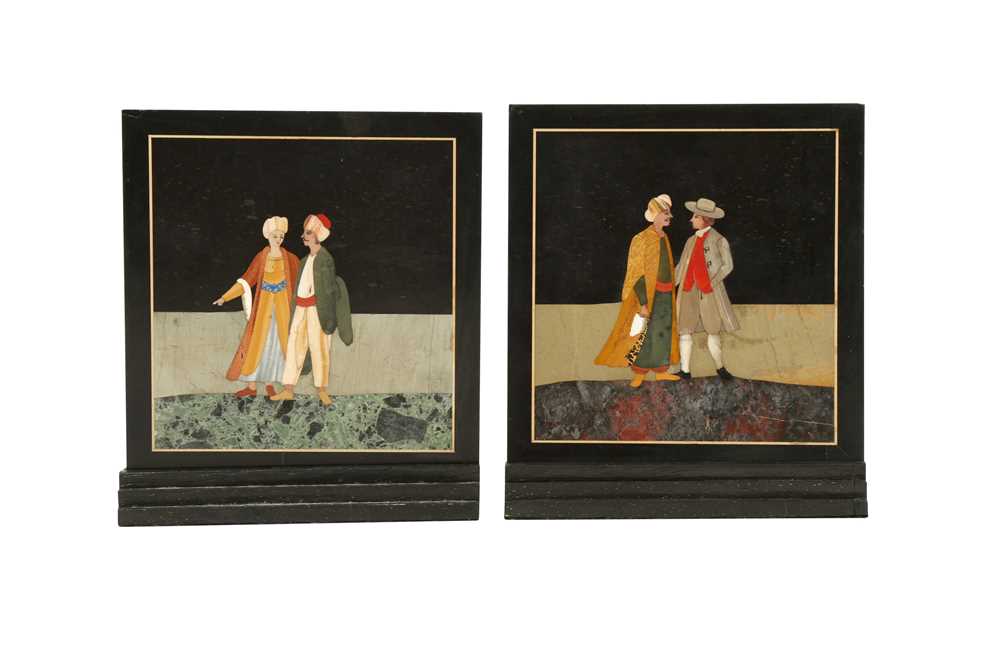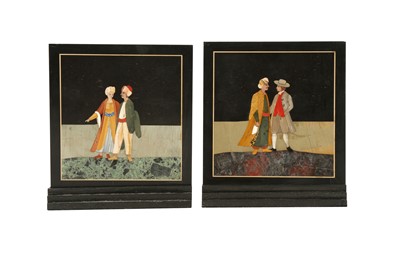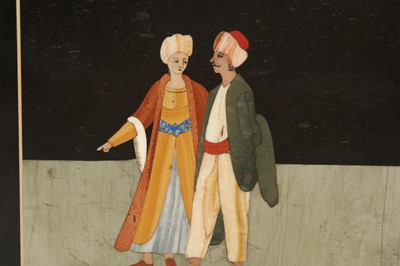3rd Nov, 2021 11:00
A Middle Eastern Journey
TWO SMALL FLORENTINE PIETRA DURA PANELS WITH TURKISH AND EUROPEAN FIGURES
Possibly Florence, Italy, in the style of Antonio Cioci's pietra dura inlays, circa 1780 - 1800
TWO SMALL FLORENTINE PIETRA DURA PANELS WITH TURKISH AND EUROPEAN FIGURES
Possibly Florence, Italy, in the style of Antonio Cioci's pietra dura inlays, ca. 1780 - 1800
Each of square shape, the tile-sized black stones, possibly basalt, inlaid with a variety of colourful hardstones including jaspers, marbles and agates portraying pairs of figures in conversation, their attires showing a melange of Western and Eastern fashion standards, the first panel with an elegant European gentleman wearing a grey suit with a large hat and red waistcoat, speaking with a man wearing a long ochre kaftan, green robe, and white turban, possibly a Turkish or Greek merchant, the latter panel with two Oriental characters, one dressed in a long ochre robe and red kaftan, the other with wide cream trousers and long green coat, with wooden stands, each 13cm x 12.5cm.
These two pietra dura panels are a wonderful example of the goût turc and the fascination with Ottoman costumes and traditions spreading throughout Europe in the 18th and 19th centuries. Their subjects may be inspired by the Ottoman world, but the technique with which they were produced digs its roots in the West, most precisely in Italy. Indeed, the accomplished and complex decorative art of pietra dura inlay, a technique in which highly polished coloured stones are cut and fitted onto a hardstone panel to create images, first appeared in Ancient Rome in the form of opus sectile, mostly used for architectural decorations in floors and on walls, with both geometric and figurative designs. In the Italian Renaissance, this technique reached its full maturity, spearheaded by great lapidary masters working at the Opificio delle Pietre Dure. Antonio Cioci (1722 - 1792), a Florentine artist, painter and decorator, is known to have had contacts with the Opificio since at least 1771, and several of his drawings and sketches inspired unique pietra dura creations like his still life of Chinese vases and Etruscan and Ancient Greek urns, today part of the Opificio museum's collection. His works always featured very vibrant colours, a good sense of volume and depth, and perfectly cut and polished stones, in a style not dissimilar to our panels.
Already by the first half of the 17th century, smaller objects produced by the Opificio were widely diffused throughout Europe and the Ottoman Empire, and as far East as to the court of the Mughal Emperors, showing the craze and fascination for this artistic production. The export of pietra dura work was extremely important to the Florentine economy and this led the lapidary masters to constantly strive to conceive innovative and unusual designs and patterns, following broader trends and styles popular in Europe and abroad. The choice of Turkish / Ottoman subjects fed into the typical 18th-century European love for turqueries and the fascination with Ottoman art, culture, fashion and lifestyle, as testified by a number of important Oriental costume books, the most famous possibly being Nicolas de Nicolay's Travels in Turkey published in 1567.
Private UK collection - purchased in the French art market 15 - 20 years ago.
Sold for £8,750
Includes Buyer's Premium
Do you have an item similar to the item above? If so please click the link below to submit a free online valuation request through our website.





